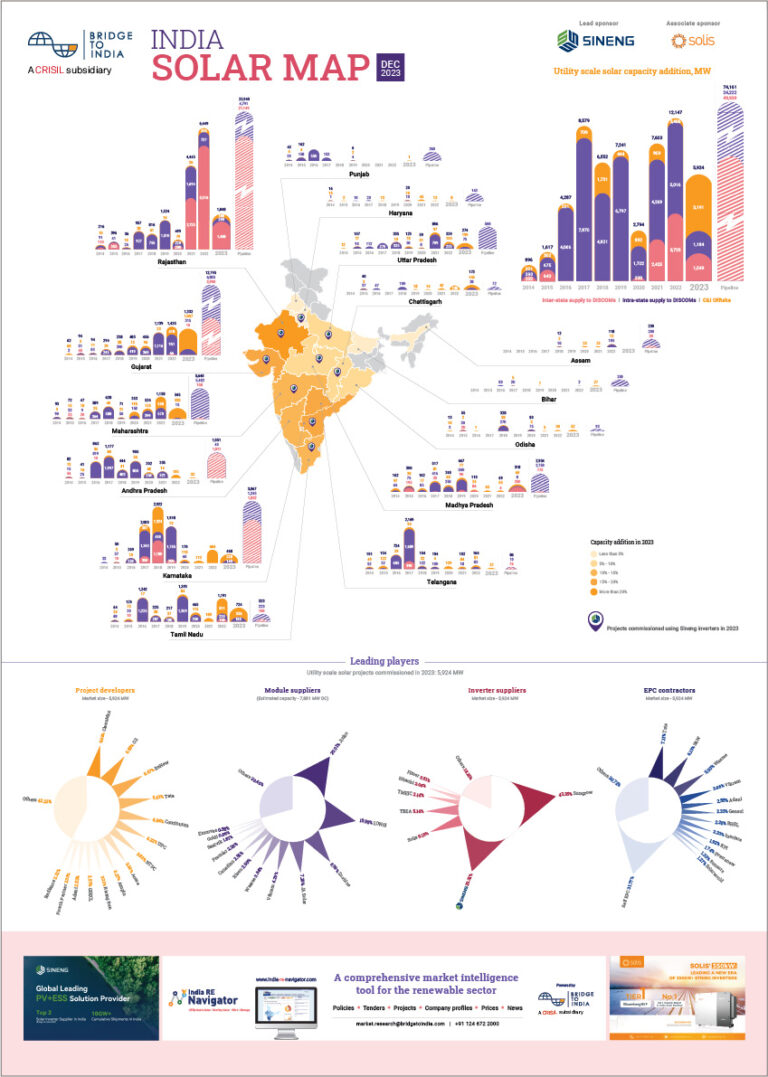India’s new government is revamping the National Solar Mission (NSM). The target has been revised to 100 GW by 2022 from the originally envisaged 20 GW. Based on unconfirmed information, 30 GW has been earmarked to come from distributed generation. This target is very ambitious, considering the fact that India’s current distributed solar capacity is only 285 MW, which is less than 1% of the target (refer to our recent India Solar Rooftop map).
- Space will not be a constraint for installation of 30 GW as the theoretical potential of rooftop solar in India is over 132 GW by 2022 (refer to our recent report)
- Not the entire 30 GW can be built on government subsidy – nor is it necessary. But government support can help kick the market off
- Cost effective storage solutions will be the game-changer for the distributed solar market
Until now, the Indian solar market has been dominated by utility scale projects. They make up over 90% of the current 3 GW (as per the BRIDGE TO INDIA project database). We believe that a healthy distributed solar market will lead to a sustainable growth of the entire sector. However, first reaching scale in distributed generation is significantly more challenging than in utility scale projects.[1]
The definition of distributed systems will be crucial in achieving this target. Apart from rooftop projects, the government might include small ground mounted projects and micro grids under the distributed system category.
The potential for solar on India’s rooftops is huge. We estimate the realizable potential in the industrial and commercial segment at 62 GW and in the residential segment at 70 GW.[2] From this perspective India’s plan to install 30 GW is feasible.
Without government support, however, the growth in the Indian solar rooftop market will not be sufficient to reach the target. BRIDGE TO INDIA estimates that India could add only 1.5 GW of rooftop solar by 2018 without any government support, just based on commercial parity.[3] To accelerate adoption, the government needs to make solar more attractive.
Though the Ministry of New and Renewable Energy (MNRE) has in the past already offered subsidies for rooftop projects, only 36 MW out of the 285 MW (13%) of current projects have actually received it. Since the subsidy has not been available as widely and as quickly as needed, it has had an adverse effect and stalled the market development. Recent statements by Power Minister Piyush Goyal, clearly suggest that the ministry understands the shortcomings of the old system and is ready to provide a more supportive framework.
In addition, the government has to create a market for rooftop solar. The first step in this direction is consumer awareness. While the idea of generating power from solar is intuitively appealing in a country that suffers from heat and power cuts, very few consumers are actually knowledgeable enough about the pros and cons of solar to take a purchase decision. Especially residential consumers are largely unaware of the mechanism and uses of solar power. The government should support channels for consumer education.
A third aspect is clear and transparent grid rules: net-metering should be implemented across all states. Additionally, accelerated a depreciation benefit or tax credit could be made available to retail consumers for enhancing the viability of residential solar systems. The biggest impediment for adoption of solar power is the high up front cost. The government should extend priority sector status to solar installations to ensure easier access to consumer finance.
In most parts on India, the grid is unreliable. Only some urban, semi-urban and industrial areas enjoy continuous power supply. Grid-connected solar systems will not be able to penetrate into areas of lower power security unless they can provide a solid back-up solution. This could be achieved first in conjunction with diesel gensets. Later it would be achieved through cost-effective storage. This would be the real game-changer for the distributed solar market.
[1] Refer to our blog, “Utility scale projects are easiest to implement in India due to an existing track record”, http://bit.ly/1rSvVni
[2] Refer our report, “How should India drive its solar transformation? Beehives or Elephants”, http://bit.ly/Vq9pmR
[3] Refer our India Solar Rooftop Map 2015, http://bit.ly/1sUbqUK
Mudit Jain is a Consultant at BRIDGE TO INDIA












